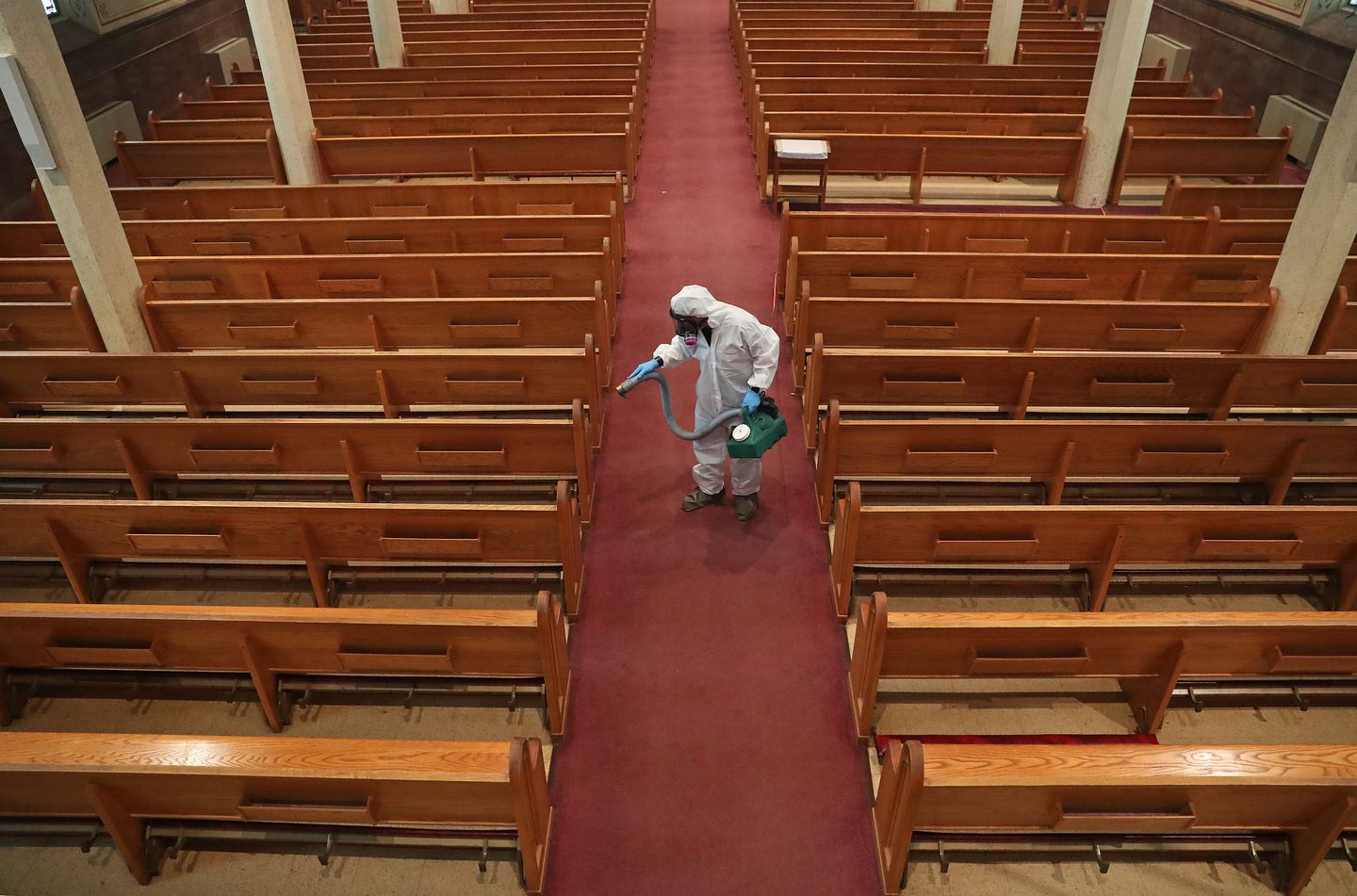by TheChurch.Digital: Welcoming back your folks is not going to be easy. Some have likened it to launching a campus or even planting a church. I don’t think it is gonna be that difficult, but I do acknowledge it’s not gonna be easy. That being said, with some focused coaching and increased effort, you will be able to welcome your people back to safe, spacious and sanitized services.
There are also unique circumstances each of our churches face like population density, denomination differences and how your governor is feeling this morning. But I have compiled generic best practices that apply to all of us regardless of your unique circumstances. Also, you may have already reopened. Don’t worry, you can still implement the best practices below.
Communication
Before we talk about creating services we need to talk about communication that will set you up for success. These three foundational communication points will ensure your people know your plan and want to actually participate in it.
1st – Survey Communication
Survey your people. If you haven’t done this already, DO IT. It will garnish valuable and actionable information. I serve on the executive team at ?Christ Fellowship Miami?, and we discovered a ton of useful info through our survey. The biggest discovery was our volunteers were coming back in thirds. A third would be willing to serve once we reopened, a third a couple weeks after we reopened and a third a couple months after we reopened. The discovery of a decreased volunteer base had major implications for how we planned our reopening.
A survey also communicates you value the feedback of your congregation. There will always be folks that throw stones at your leadership and plans, but you minimize that group and the stones they can throw by giving them a voice into the process through a survey. Here are a couple of very practical ways to conduct the survey.
Keep it anonymous to allow greater levels of honesty.
Incentivized participation by allowing people to provide their email address to be entered into a gift card draw.
Consider Google Forms for the survey. It is easy to use, gives real time results and puts all the data into pretty charts.
Provide a catch-all question at the end of the survey with “anything else you would like us to know”.
If you want to survey your folks, but don’t know what questions to ask, then visit benstapley.info/welcomeback? for a free downloadable template survey. It will help you hit the ground running.
2nd – Over, Cluster & Deadline Communication
You need to step up your communication game by over communicating, cluster communicating & deadline communicating.
Over communicate by repeating your main talking points until you’re sick of hearing them. Then repeat some more. Your goal should be to communicate so much that you start hearing people parrot what you’ve said.
It can be confusing to send out updates to your staff and guests every day. Cluster communication combines your talking points, allows people to get multiple points of information at once and avoids this confusion. If you don’t practice this principle, people will stop listening to your bombardment of singular communication.
Even if you don’t have answers or info at present, let people know when you will. This is deadline communication. You might not be able to make the call on when you are reopening right now, but at least let people know when you will. Deadline communication brings comfort and calm to wondering and worried hearts during a stressful season.
3rd – Confidence Communication
Discern when God has called you to reopen and execute that. On one end of the spectrum there is Ed Young and ?Fellowship Church?. They reopened weeks after Easter. On the other end there is Andy Stanley and ?North Point Community Church?. They won’t reopen until they can do church like they did before. After you prayerfully consider when God is calling you to reopen, confidently communicate it to your congregation. Remember, what is right for you isn’t necessarily right for others. So refrain from scolding churches that disagree with you.
Creating Safe Services
Now that we’ve covered foundational communication, let’s talk about creating safe services. Here are five ways to do that.
Symptoms? – In your communication before you reopen, encourage anyone that is experiencing COVID-19 symptoms to stay home. This releases any unnecessary pressure of having to make it to church for guests with symptoms. It also gives guests without symptoms a greater degree of confidence in coming.
Masks? – I recommend you require all staff and volunteers to wear masks and that you encourage guests to wear them. Also, provide masks for any guest that forgot theirs at home. That being said, if a guest doesn’t want to put a mask on, I wouldn’t prevent them from entering your auditorium. The risk they present to the other guests is pretty minimal and you could have a very volatile situation on your hands if you start banning unmasked guests from entering.
Touchless Thermometers? – Keep a couple of touchless thermometers on hand. This allows volunteers or guests to have their temperature tested if requested. A volunteer might feel fine getting ready in their air conditioned home. But after serving for an hour at your church during summer, their temperature may rise. A touchless thermometer is a quick and easy way to verify if your body is just naturally feeling warm or if you are experiencing COVID-19 symptoms.
Touchless Experience? – Aim to provide a touchless experience. There are a number of ways you can do this. Ditch the bulletin and provide message notes on your website. Remove the bible from your pews or chairs and direct people to an app. Use a texting service for digital connection cards instead of physical ones. Stop passing the plate and provide a drop-off location at the exit for cash and checks. Or better yet, encourage recurring giving online. Other than the bathroom, prop open all doors. Cause no one wants to hear you doing your business.
Food & Beverages? – Stop providing unpackaged food and beverages to your staff, volunteers and guests. Stick to individually wrapped items such as granola bars, crackers and bottled water.
Creating Spacious Services
So we talked about creating safe services now let’s talk about creating spacious services. Here are five ways to do that.
Limit Capacity ?- To ensure guests are seated six feet apart you probably need to limit your seating capacity to 25%. You may want to ask guests to reserve seats. This helps you have enough volunteers and seats to meet the demand. ?EventBrite? and ?Planning Center? are two great platforms for event registration. Check out ?cfmiami.org/reopen? to see an example of this.
Limit Contact? – The more we limit contact, the more we limit infection. So here are a number of ways to do that. Fist bumps and elbow touches instead of bear hugs and high fives. Ask people to submit prayer requests through your online connection card instead of calling them forward at the end of the service. And stop the meet and greet. No longer needing to say hello to your neighbor during church may be the only silver lining with COVID-19.
Limit Flow? – Limit traffic flow to one-way throughout your experience to ensure the safety of everyone. There should be a seamless flow of people from your parking lot, into your auditorium and the back into the parking lot. How folks connect and interact in the parking lot after the service is over is on them.
Model Spacious Behavior ?- No one is gonna remember your rules when they show up. So you have to model spacious behavior. Coach your staff and volunteers to refrain from their natural instincts to bear hug a good friend they haven’t seen in months. Lead pastors, this is gonna be hardest for you cause the majority of people will be approaching you. Wave at guests before they approach. This lets them know you love them but that they should keep their distance.
Provide Spacious Seating? – When people enter, seat them from the front to the back. Skip every other row and leave three seats between clusters of people. Also since your worship team will be singing in the direction of your guests, start the first row of seats fifteen feet from the stage. This will limit air particles projected onto guests. When the service is ending the pastor should instruct how to exit. The safest way is wedding style with ushers releasing rows from the back to the front.
Creating Sanitized Services
So we talked about creating spacious services now let’s talk about creating sanitized services. Here are three ways to do that.
Hand Sanitizer? – Place hand sanitizer stations at entrances and exits. Nuff said.
Clean Before Service? – Provide professional-level cleaning before, during and after each service. I suggest using an electrostatic spray, which is recommended by the CDC, to clean all of the chairs and surfaces in your auditorium. It only takes ten minutes to dry and this ensures your guests sit on a sanitized chair.
Reopen In Phases? – The easiest way to keep things sanitized is by reopening in phases. This is because kids struggle with keeping social distance. So start with a family friendly service with no kids program. Then after schools in your area start allowing students back into the classroom, consider reopening your kids program. If parents are comfortable sending their kids back to school, they will probably feel comfortable sending them back to church as well.
Conclusion
So those were my tips on how to welcome back your church by creating safe, spacious & sanitized services. If I missed any tips let me know. I would love to hear from you and learn from you. You can ?email? me at benstapley@gmail.com and read more blogs at ?benstapley.info?. Have yourself an awesome day.
![]()

